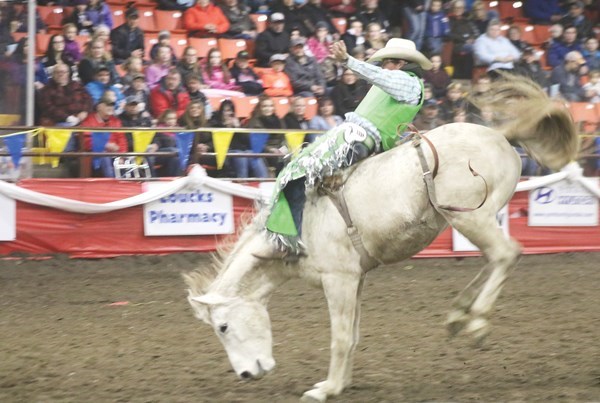When the championship round was held at this year’s Calgary Stampede a cowboy who got his start in the sport while living at nearby Inglis, MB., was among the top-four vying for the bareback riding crown.
Orin Larsen would draw a horse that would not co-operate in the chute, and be assigned a new ride.
Larsen would ride the new draw. Unfortunately, ‘Trail Dust’ just didn’t perform up to championship standards, and his 88.5 score was well shy of the top score of 93.5 by American Tim O’Connell.
Larsen finished third.
“It was just one of those deals. I had a good horse drawn,” he said in an interview just days after the final.
The re-ride horse just wasn’t up to it, he added without a great deal of disappointment.
“I was just fortunate to be at Calgary,” said Larsen. “At the end of the day you’re still riding at the greatest outdoor show.”
Not that turning out at the Stampede is new for the full-time bareback rider, who said he has been at about half a dozen – a very good record for the cowboy who won his first pro rodeo event in 2011.
Turning pro was a natural step for Larsen who won the bareback riding championship at the College National Finals Rodeo in 2013 while competing for College of 小蓝视频ern Idaho and repeated in 2014 after transferring to the Panhandle State; he was sixth at the 2012 Canadian National Finals Rodeo and also qualified in 2011.
The decision to go pro has proven a good one.
In 2020 alone Larsen won the Buffalo Stampede (Kadoka, S.D.), the Coleman (Texas) PRCA Rodeo, the Dinosaur Roundup Rodeo (Vernal, Utah), the Wolf Point (Mont.) Wild Horse Stampede and the Yellowstone Riggin Rally (Darby, Mont.). Co-champion at the Crossett (Ark.) Riding Club 72nd Annual PRCA Rodeo, the Pony Express Rodeo (Eagle Mountain, Utah) and the McCone County Fair PRCA Rodeo (Circle, Mont.), according to
And, he has career earning in excess of $1.2 million.
Larsen said that number sounds impressive, and it is indicative of much success, but it doesn’t factor in the costs of the pro rodeo circuit.
“I’ve been very fortunate, but it’s a lot of airplane rides, and time away from home and entry fees,” he said.
All those miles started because of family.
Larsen said he was born in Strathmore, AB., moving to Manitoba when he was about eight. Rodeo was in his blood from the start.
“Dad rode bulls in the 70s and 80s,” he said.
“My older brother started on calves and steers when he was 12, or 13. I wanted to be as good as he was, if not better.”
In time though Larsen said his interested faded in riding bulls.
“I didn’t enjoy it anymore. It wasn’t fun,” he said.
But bareback riding was a different story. Larsen loved the challenge.
“It’s just lots of energy ... I think it’s one of the hardest events in rodeo,” he said.
So what does it take to be a good bareback bronc rider?
“I’m still trying to figure that out,” said Larsen, then adding riders need to be physically and mentally tough.
As a full-time rider Larsen is on the road a lot. In the days after the interview he was scheduled to ride at events on Ogden and Salt Lake City, Utah, Nampa, Idaho and Cheyenne, Wyoming. He explained riders are allowed to ride 100 times a year with the scores going toward world standings.
“I typically don’t like to go for 100 rides . . . I’m looking at the long term of my career,” he said, adding it’s been a number of years since he pushed that hard, preferring to focus of getting on quality horses he can score well on.
Interestingly, while you might expect a certain ride to be a career highlight, or a certain championship buckle or bronze statue, Larsen picks a moment that ties back to his start in the sport – family. It was at the Canadian Finals in 2018, and he was there with both his brothers; Tyrel in saddle bronc and Kane riding bulls.
“You don’t have that kind of thing often,” he said, with pride obvious in his voice.





